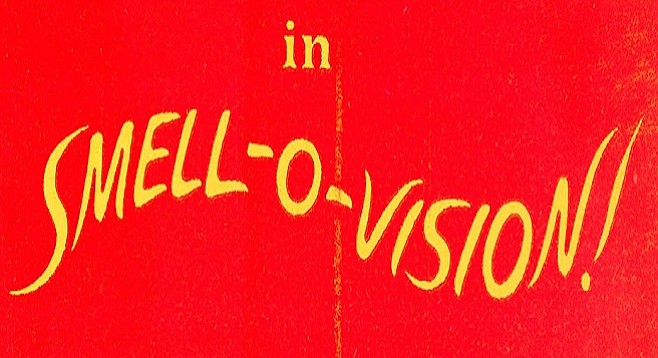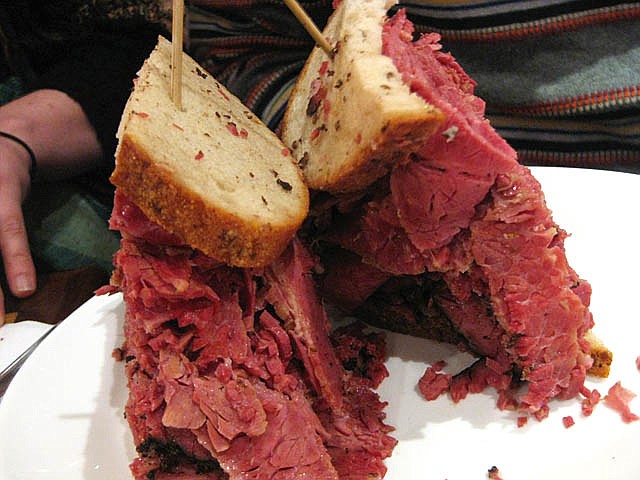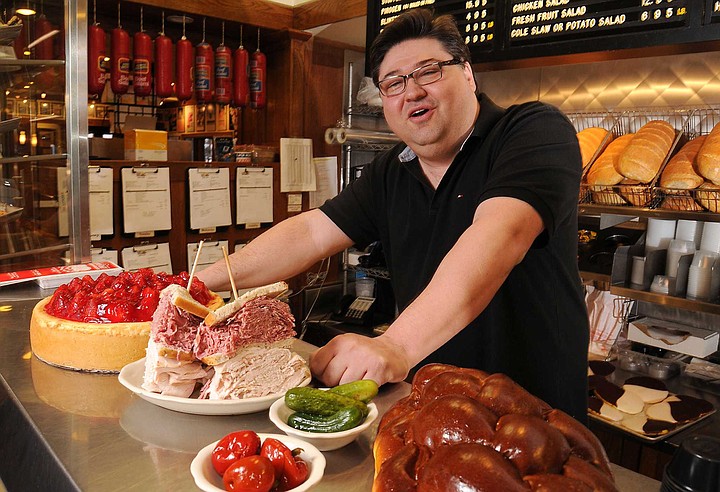 Facebook
Facebook
 X
X
 Instagram
Instagram
 TikTok
TikTok
 Youtube
Youtube

An oral history of a uniquely American institution as told by third- and fourth-generation counter-men and women. Delicatessens first began dotting the American landscape in the mid-1800s, the time of the great German immigration. At first a confederacy of Jews and Germans, the latter group was eventually replaced by Yiddish-speaking Russians. In their prime, approximately 2000 delis operated in New York City alone. Today, only 5 of the majors remain. The film features testimonials from authors, operators, aficionados, and many a celebrity denizen — whose signed photos ceremonially adorn the walls of many a first-class deli — including Larry King, Fyvush Finkel, and Jerry Stiller. Director Director Erik Anjou positions Ziggy Gruber, a giant, unwed Pillsbury Doughboy stuffed with kishke and gribenes, as both a deli man extraordinaire and the film’s star subject. Just prior to shooting, he met the goyishe-kop woman of his dreams, a Catholic acupuncturist named Mary, in synagogue. Anjou and his camera follow Ziggy and Mary to a synagogue in Budapest, the same one in which Grandpa Gruber became a man, to begin their own tradition of happily ever after. (Perhaps a spolier alert was in order, but how can a healthy appetite — be it for food or romance — spoil anything?) You’re bound to leave hungry.
“Corned beef is responsible for killing more of my people than Hitler.” — Jerry Lewis
A fragrant bouquet of savory sliced beef and smoked fish mixes with chopped organ meat smothered in onions and rendered chicken fat assaults the schnoz the moment the front door cracks, orbiting through one’s nostrils like two giant knaidlach-sized fists demanding that your vagus nerve tell your brain it’s time to nosh. This could be said of any of the dozen or so quality delis in Chicago’s North Rogers Park neighborhood where I grew fat chowing down.
It wasn’t always the quality of the food that drew me, although growing up in a town that at one time boasted nosheries at every major intersection made it next to impossible to find anything but prime deli eats. Jerry’s Deli on the near North Side may not have sliced up the city’s finest brisket, but the floor show was to die for. Jerry didn’t suffer fools lightly. If anything, he made them suffer. After all, his was a glorified lunch counter with a few scattered tables and limited menu, not the Pump Room.
“Today, not tomorrow!” and “Whaddya’, picking out jewelry?” were Jerry’s favorite means of venting frustration over a customer taking too long to make up their mind. If you hadn’t decided on a selection by the time your number came up, testy Jerry or one of his battle-scarred underlings would point you in the direction of the back of the line. And you’d sooner find a kosher meal on Air Hitler than have your request for ketchup to squeeze on a hot dog met with anything but Jerry’s appalled scowl.
Deli Man is an oral history of a uniquely American institution as told by third- and fourth-generation counter-men and women. While none of the deli operators interviewed in Erik Anjou’s mouthwatering documentary are as irascible as Jerry, one server comes close when he (half) jokingly admits, “I treat customers like mushrooms: feed ’em shit and keep ’em in the dark.”
Mustard splashes across the screen, spelling out the title in squirt-bottle cursive. Delicatessens first began dotting the American landscape in the mid-1800s, the time of the great German immigration. At first a confederacy of Jews and Germans, the latter group was eventually replaced by Yiddish-speaking Russians. David “Ziggy” Gruber’s grandfather opened New York’s first Broadway delicatessen, the Rialto, during the height of the great depression. In their prime, approximately 2000 delis operated in New York City alone. Today, only 5 of the majors remain.

The film features testimonials from authors, operators, aficionados, and many a celebrity denizen — whose signed photos ceremonially adorn the walls of many a first-class deli — including Larry King, Fyvush Finkel, and Jerry Stiller. It was Lindy’s, located in the Broadway Theatre District, that kicked off the long-standing tradition of serving up sandwiches named after celebrities. How about a combination of tongue, turkey, Swiss cheese, coleslaw, and Russian dressing on rye? That’s what Jack Benny and Mary Livingstone would order when in New York. “How sweet it is!” purred Jackie Gleason after feasting on the turkey, bacon, onions, tomatoes, and Russian dressing sandwich that bore his name. “Oh, yeah! Timpani!” yelped Jerry Lewis when taking his own advice by side-stepping fatty meats in favor of a turkey, tomato, and crisp bacon creation.
According to Milton Berle, the “Henny Youngman” was all ham and tongue. Dubbed by one fresser “the cheapest bastard in the history of the world,” Henny was the Carnegie Deli’s greatest customer inasmuch as he always found ways to eat on the arm. The King of the One-Liners would enter to applause, work the crowd with a couple of throwaway jokes, and expect a free meal in exchange for his “set.”

The only fowl mentioned in the picture is boiled chicken, but that won’t stop me from recalling another incurably heartfelt documentary, The Wild Parrots of Telegraph Hill, aided and abetted by a spontaneous on-set romance that gives the film an added human interest touch. Anjou positions Ziggy, a giant, unwed Pillsbury Doughboy stuffed with kishke and gribenes, as both a deli man extraordinaire and the film’s star subject. It will take a lot to convince Jews that great deli exists south of the Mason-Dixon line. So as not to prejudice the audience, Anjou and crew wait a good 15 minutes to establish Ziggy’s deserved reputation as the Duke of Deli before revealing his home base, Houston, Texas.
Ziggy, born with a dill pickle spear on his back, was not yet Bar Mitzvahed when he first started apprenticing in his grandfather’s kitchen. While in his twenties, Ziggy attended his first deli convention. Surrounded by men in their eighties, pisher Ziggy vowed to carry on a tradition wherein a sandwich and a pickle constituted a meal. Just prior to shooting, he met the goyishe-kop woman of his dreams, a Catholic acupuncturist named Mary, in synagogue. Her interest in alternative forms of religion brought them together at an event catered by Ziggy.
Deli Man would be nothing without a strict adherence to established tradition. (Jewish fusion is briefly touched upon, but if I’m ever spotted waiting in line for pastrami fries, please shoot me.) Anjou and his camera follow Ziggy and Mary to a synagogue in Budapest, the same one in which Grandpa Gruber became a man, to begin their own tradition of happily ever after. Perhaps a spolier alert was in order, but how can a healthy appetite — be it for food or romance — spoil anything?
You’re bound to leave hungry. Believe it or don’t, San Diego has at least three quality delis that I’ll personally vouch for, any one of which would be a superb spot for a post-show refreshment. (Whatever you do, steer clear of Schlotzsky’s. Better to eat your young than what passes for deli at this chazerai pit.) The logical choice would be Elijah’s, located around the corner from the Landmark La Jolla Village. There’s also Milton’s in Del Mar, and my home away from home, D.Z. Akin’s in the College Area. Milton’s deli lists their prices by the half-pound, while Akin’s doesn’t even offer a menu board. Jerry was right: time to start selling corned beef by the carat.
Rating: Four Stars


An oral history of a uniquely American institution as told by third- and fourth-generation counter-men and women. Delicatessens first began dotting the American landscape in the mid-1800s, the time of the great German immigration. At first a confederacy of Jews and Germans, the latter group was eventually replaced by Yiddish-speaking Russians. In their prime, approximately 2000 delis operated in New York City alone. Today, only 5 of the majors remain. The film features testimonials from authors, operators, aficionados, and many a celebrity denizen — whose signed photos ceremonially adorn the walls of many a first-class deli — including Larry King, Fyvush Finkel, and Jerry Stiller. Director Director Erik Anjou positions Ziggy Gruber, a giant, unwed Pillsbury Doughboy stuffed with kishke and gribenes, as both a deli man extraordinaire and the film’s star subject. Just prior to shooting, he met the goyishe-kop woman of his dreams, a Catholic acupuncturist named Mary, in synagogue. Anjou and his camera follow Ziggy and Mary to a synagogue in Budapest, the same one in which Grandpa Gruber became a man, to begin their own tradition of happily ever after. (Perhaps a spolier alert was in order, but how can a healthy appetite — be it for food or romance — spoil anything?) You’re bound to leave hungry.
“Corned beef is responsible for killing more of my people than Hitler.” — Jerry Lewis
A fragrant bouquet of savory sliced beef and smoked fish mixes with chopped organ meat smothered in onions and rendered chicken fat assaults the schnoz the moment the front door cracks, orbiting through one’s nostrils like two giant knaidlach-sized fists demanding that your vagus nerve tell your brain it’s time to nosh. This could be said of any of the dozen or so quality delis in Chicago’s North Rogers Park neighborhood where I grew fat chowing down.
It wasn’t always the quality of the food that drew me, although growing up in a town that at one time boasted nosheries at every major intersection made it next to impossible to find anything but prime deli eats. Jerry’s Deli on the near North Side may not have sliced up the city’s finest brisket, but the floor show was to die for. Jerry didn’t suffer fools lightly. If anything, he made them suffer. After all, his was a glorified lunch counter with a few scattered tables and limited menu, not the Pump Room.
“Today, not tomorrow!” and “Whaddya’, picking out jewelry?” were Jerry’s favorite means of venting frustration over a customer taking too long to make up their mind. If you hadn’t decided on a selection by the time your number came up, testy Jerry or one of his battle-scarred underlings would point you in the direction of the back of the line. And you’d sooner find a kosher meal on Air Hitler than have your request for ketchup to squeeze on a hot dog met with anything but Jerry’s appalled scowl.
Deli Man is an oral history of a uniquely American institution as told by third- and fourth-generation counter-men and women. While none of the deli operators interviewed in Erik Anjou’s mouthwatering documentary are as irascible as Jerry, one server comes close when he (half) jokingly admits, “I treat customers like mushrooms: feed ’em shit and keep ’em in the dark.”
Mustard splashes across the screen, spelling out the title in squirt-bottle cursive. Delicatessens first began dotting the American landscape in the mid-1800s, the time of the great German immigration. At first a confederacy of Jews and Germans, the latter group was eventually replaced by Yiddish-speaking Russians. David “Ziggy” Gruber’s grandfather opened New York’s first Broadway delicatessen, the Rialto, during the height of the great depression. In their prime, approximately 2000 delis operated in New York City alone. Today, only 5 of the majors remain.

The film features testimonials from authors, operators, aficionados, and many a celebrity denizen — whose signed photos ceremonially adorn the walls of many a first-class deli — including Larry King, Fyvush Finkel, and Jerry Stiller. It was Lindy’s, located in the Broadway Theatre District, that kicked off the long-standing tradition of serving up sandwiches named after celebrities. How about a combination of tongue, turkey, Swiss cheese, coleslaw, and Russian dressing on rye? That’s what Jack Benny and Mary Livingstone would order when in New York. “How sweet it is!” purred Jackie Gleason after feasting on the turkey, bacon, onions, tomatoes, and Russian dressing sandwich that bore his name. “Oh, yeah! Timpani!” yelped Jerry Lewis when taking his own advice by side-stepping fatty meats in favor of a turkey, tomato, and crisp bacon creation.
According to Milton Berle, the “Henny Youngman” was all ham and tongue. Dubbed by one fresser “the cheapest bastard in the history of the world,” Henny was the Carnegie Deli’s greatest customer inasmuch as he always found ways to eat on the arm. The King of the One-Liners would enter to applause, work the crowd with a couple of throwaway jokes, and expect a free meal in exchange for his “set.”

The only fowl mentioned in the picture is boiled chicken, but that won’t stop me from recalling another incurably heartfelt documentary, The Wild Parrots of Telegraph Hill, aided and abetted by a spontaneous on-set romance that gives the film an added human interest touch. Anjou positions Ziggy, a giant, unwed Pillsbury Doughboy stuffed with kishke and gribenes, as both a deli man extraordinaire and the film’s star subject. It will take a lot to convince Jews that great deli exists south of the Mason-Dixon line. So as not to prejudice the audience, Anjou and crew wait a good 15 minutes to establish Ziggy’s deserved reputation as the Duke of Deli before revealing his home base, Houston, Texas.
Ziggy, born with a dill pickle spear on his back, was not yet Bar Mitzvahed when he first started apprenticing in his grandfather’s kitchen. While in his twenties, Ziggy attended his first deli convention. Surrounded by men in their eighties, pisher Ziggy vowed to carry on a tradition wherein a sandwich and a pickle constituted a meal. Just prior to shooting, he met the goyishe-kop woman of his dreams, a Catholic acupuncturist named Mary, in synagogue. Her interest in alternative forms of religion brought them together at an event catered by Ziggy.
Deli Man would be nothing without a strict adherence to established tradition. (Jewish fusion is briefly touched upon, but if I’m ever spotted waiting in line for pastrami fries, please shoot me.) Anjou and his camera follow Ziggy and Mary to a synagogue in Budapest, the same one in which Grandpa Gruber became a man, to begin their own tradition of happily ever after. Perhaps a spolier alert was in order, but how can a healthy appetite — be it for food or romance — spoil anything?
You’re bound to leave hungry. Believe it or don’t, San Diego has at least three quality delis that I’ll personally vouch for, any one of which would be a superb spot for a post-show refreshment. (Whatever you do, steer clear of Schlotzsky’s. Better to eat your young than what passes for deli at this chazerai pit.) The logical choice would be Elijah’s, located around the corner from the Landmark La Jolla Village. There’s also Milton’s in Del Mar, and my home away from home, D.Z. Akin’s in the College Area. Milton’s deli lists their prices by the half-pound, while Akin’s doesn’t even offer a menu board. Jerry was right: time to start selling corned beef by the carat.
Rating: Four Stars
Comments